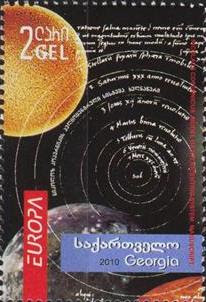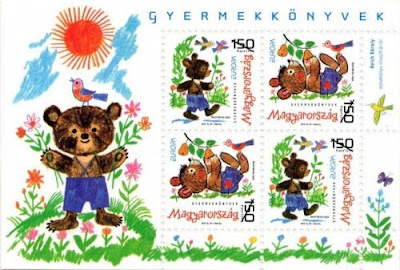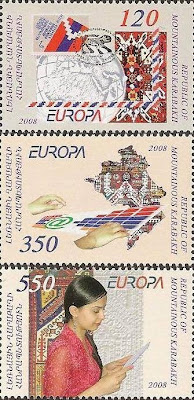 Georgia
GeorgiaDate of Issue: 15th October 2010 [!]
two stamps (2.- & 3.- GEL) & souvenir-sheet of two stamps (2.- & 3.- GEL)



both stamps are issued in mini sheets of 10 stamps


both stamps are issued in a booklet of 8 stamps (4 stamps of each)


 Georgia
Georgia






 Hungary
Hungary


 Finland
Finland

 Europe
Europe Albania
Albania Georgia
Georgia Europe
Europe


 Europe
Europe Europe
Europe Armenia
Armenia

 Europe
Europethe Faroe Is., Iceland and Ireland issued a twin issue that year.

 Europe
Europe"In 1993, the CEPT decided to concentrate on telecommunication issues only and the Europa stamps issues coordination was transmitted to PostEurop the association of European public postal operators. Since then a new logo is in use on Europa stamps."
"That year two unofficial issues appeared. The first one from: Belarus; although the new logo was introduced that year they used the old CEPT on there stamps. The other one from the Croat post of Bosnia and Herzegovina. It was the first postal administration of Bosnia to issue Europa stamps but they weren't recognized by the UPU at that time, that's why their issue is also considered as unofficial."
 Liechtenstein
Liechtenstein9th September 1960 saw the appearance of Liechtenstein’s first Europa stamp (face value CHF 0.50). The name EUROPA was embedded in it in a honeycomb pattern. This was also the first stamp designed by the then 30-year-old Mauren graphic designer Louis Jäger, who has since been responsible for several masterly pieces of philatelic design (he draw also the 1975 Europa issue).
The publication “50 Years of Liechtenstein Postage Stamps 1912–1962” describes the stamp, a first work in two senses, thus: “In 1960 a great structure is evolving cell by cell, but it will be some time yet before it is complete: many cells are still unfilled or incompletely filled: Europe is not yet complete. It can however be finished if its builders continue building on the common foundation laid in antiquity and the Christian era: hence the letters of the alphabet modelled on Roman characters. Thus will it all be able to coalesce and jointly grow together.” (p. 313).
There were however two more unusual features which attracted collectors’ attention to Liechtenstein’s first Europa stamp. Firstly, it was published in an edition of only 322 000 and was consequently very quickly sold out (subsequently Liechtenstein’s Europa stamps have each appeared in editions of over 1.5 million). What also made this stamp a true collector’s item was the fact that there were both a second edition and a very small edition of imperforate test prints.
 Great Britain
Great Britain

 Europe
Europe




 Europe
Europe"Croatia is the first ex-Yugoslav republic to issue Europa stamps that year. They issued in fact twice the same set, one without the CEPT logo (as they weren't a CEPT member at that moment of the year) and one set later the same year with the official Europa set with the logo."
"Portugal issued one Europa stamp that year but also six souvenir-sheets depicting former stamps adding a CEPT logo on them !"
"Albania took part for the first time that year issuing a souvenir-sheet becoming very expensive those days !"
 Europe
EuropeThe Berlin Wall has fallen, and former Communist countries are becoming members of the CEPT. For the first time since 1981, the Europa stamps collection has new countries taking part.
 Europe
EuropeHungary became a CEPT member that year but to late to be able to issue official Europa stamps. Anyway they issued this year two stamps with the "post offices" theme but without the CEPT logo on it that would have made real Europa stamps of them.
 Europe
Europe